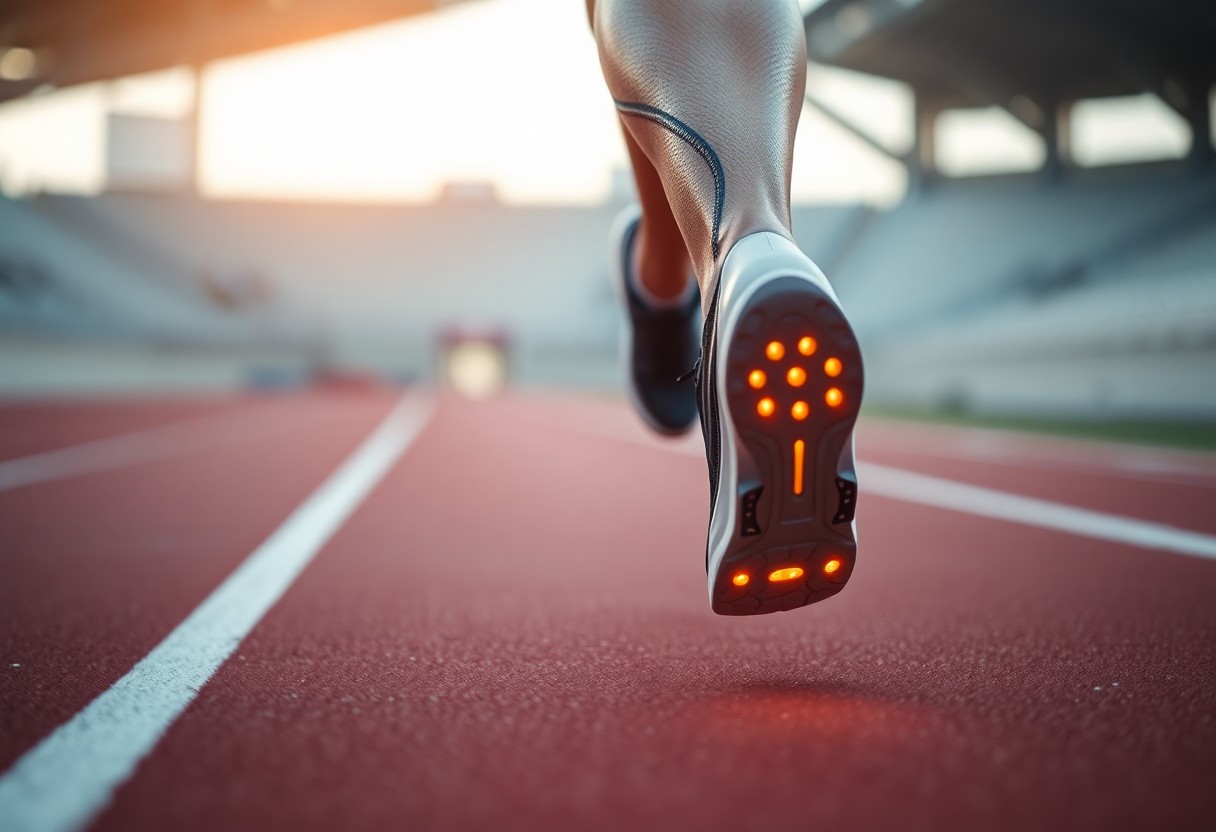
Delve into the revolutionary innovations in running footwear technology that have significantly altered the landscape for performance enhancement among endurance athletes.
The world of performance optimisation in endurance running has undergone a remarkable transformation thanks to advanced footwear technology, which presents unparalleled opportunities for you to unlock your athletic capabilities. This article will guide you through how innovative shoe designs can significantly lower your metabolic expenditure and enhance your running economy. By incorporating carbon fibre plates and state-of-the-art midsole materials, these shoes deliver exceptional energy return mechanisms that can potentially reduce your oxygen consumption by as much as 4%. Whether you are a professional athlete or a passionate amateur, grasping these biomechanical advancements can empower you to make enlightened choices regarding your running gear and may enhance your race performance.
 Continue reading to explore the intricate mechanics of running footwear designed to elevate performance:
Continue reading to explore the intricate mechanics of running footwear designed to elevate performance:
Harnessing Energy Return Mechanisms in Cutting-Edge Running Shoes
The technology behind advanced running shoes utilises intricate biomechanical principles to optimise energy transfer throughout your movement. Innovative design features function collaboratively to minimise metabolic expenditure, forming a sophisticated mechanism that enhances running efficiency through calculated material engineering and geometric designs. By concentrating on energy return dynamics, these shoes furnish runners with a substantial edge in both performance and stamina, enabling prolonged runs with diminished fatigue.
Unpacking the Curvature Dynamics of Carbon Fibre Plates
Carbon fibre plates utilise precise geometric engineering to redirect kinetic energy during the running motion. Optimal curvature angles ranging from 12° to 15° facilitate maximum energy storage and return, with finite element modelling indicating up to 93% energy return efficiency in prototype designs. These engineered plates employ a spring-like mechanism that diminishes muscular effort during toe-off phases, enabling runners to conserve energy over extended distances, thereby leading to improved endurance and overall performance.
Evaluating TPU and EVA in Midsole Innovations
The choice of materials is crucial in determining shoe performance, with thermoplastic polyurethane (TPU) emerging as a superior option for midsole technology. Comparative studies illustrate TPU’s considerable advantages in both energy return and impact absorption, offering runners enhanced biomechanical efficiency across diverse running conditions. The decision between TPU and EVA foam is pivotal for athletes aiming to optimise their performance while mitigating injury risks during training and competition.
| Energy Return | 18% higher in TPU |
| Oxygen Consumption Reduction | 2.4% lower with TPU |
An in-depth exploration of midsole materials reveals nuanced performance characteristics. TPU exhibits superior resilience compared to conventional EVA foam, maintaining consistent mechanical properties over thousands of compression cycles. Runners benefit from more reliable energy return, reduced fatigue, and improved long-distance performance through advancements in material science, which can significantly influence their overall training outcomes and competition results.
| Impact Absorption | TPU absorbs 37% more force |
| Rebound Elasticity | 89% maintained across 50,000 cycles |
 Continue to explore the impacts of cutting-edge footwear technology on metabolic efficiency:
Continue to explore the impacts of cutting-edge footwear technology on metabolic efficiency:
Evaluating Metabolic Efficiency: Understanding Who Gains from Advanced Footwear
Advanced footwear technology does not affect all runners uniformly. Gains in metabolic efficiency vary substantially across different demographic groups, with elements such as gender, age, and individual biomechanics playing pivotal roles in enhancing performance. Research has illuminated intricate patterns of metabolic response, indicating that the advantages provided by super shoes extend beyond mere performance figures to encompass complex physiological adaptations unique to each runner's biomechanical profile.
Investigating Gender-Specific Enhancements in Performance
Female runners benefit from a 3.2% metabolic power improvement, compared to a 4.2% enhancement in males, suggesting complex neuromuscular adaptations at play. Data on pelvic kinematics indicates a 14% greater reduction in hip adduction angle among females using advanced footwear, which may elucidate the subtle disparities in metabolic gains between genders. Recognising these differences can assist in tailoring training and shoe selections to maximise performance benefits for each gender.
Examining Age-Related Advantages in Endurance Performance
Masters athletes aged 40 and above demonstrate a 2.8% greater reduction in oxygen cost when using super shoes, likely offsetting declines in tendon elasticity. Analysis of tibial loading illustrates a 12% reduction in cumulative stress per kilometre for older runners, hinting at potential benefits for injury prevention and performance sustainability. These findings underscore the critical role of advanced footwear technology in extending the competitive lifespan of older athletes.
The age-related advantages of advanced footwear technology extend well beyond basic performance metrics. Biomechanical investigations reveal that older runners experience more pronounced adaptations due to compensatory mechanisms. Decreased tendon stiffness and altered muscle recruitment patterns interact synergistically with shoe technology to forge a distinct performance enhancement profile. Specifically, the energy return mechanism of the carbon plate seems to counteract age-related biomechanical inefficiencies, potentially prolonging competitive running careers by alleviating the physiological constraints typically encountered by aging athletes.
Continue reading to explore the implications of advanced footwear technology on injury risks:
Unpacking the Influence of Running Footwear on Injury Risk
Advanced footwear technology introduces intricate biomechanical interactions that necessitate a nuanced examination of potential injury risks. Runners must meticulously weigh the trade-offs between performance improvement and physiological adaptation. Longitudinal studies have indicated subtle yet significant shifts in muscular recruitment patterns, joint loading, and proprioceptive feedback when transitioning to high-performance running shoes, underscoring the necessity for a balanced approach in both training and recovery.
Injury Analysis: The Consequences of Enhanced Performance
Biomechanical studies reveal a 9% increase in Achilles tendon strain rates for super shoe users during high-intensity training. Plantar pressure mapping shows a 22% increase in forefoot loading compared to traditional trainers, especially on challenging terrains such as downhill running. These insights suggest that while improvements in metabolic efficiency may be realised, runners should implement targeted strength and adaptation protocols to mitigate potential injury risks and secure long-term athletic health.
Modifying Training Protocols for Optimal Gait Adaptations
Adapting your biomechanical response to advanced footwear necessitates strategic adjustments to your training regimen. Gait retraining becomes essential to optimise the unique energy return mechanisms present in carbon-plated shoes. Runners must concentrate on developing neuromuscular patterns that align with the shoe's biomechanical design, which can help to diminish injury risk and maximise performance benefits.
Comprehensive gait adaptation strategies encompass multifaceted approaches to effectively integrate advanced footwear technology. Biomechanical assessments indicate that runners require approximately 6 to 8 weeks of progressive training to fully adjust to the distinctive mechanical properties of super shoes. This adaptation phase involves targeted eccentric strengthening routines, modified interval training methods, and vigilant monitoring of lower limb biomechanics. Professional athletes and dedicated runners stand to gain from periodic 3D gait analysis to track minor shifts in movement patterns, ensuring the optimal integration of advanced footwear technology with individual biomechanical traits.
 Explore the future of footwear technology and its ramifications for runners:
Explore the future of footwear technology and its ramifications for runners:
Anticipating Future Innovations in Running Footwear Technology
Emerging technologies are set to redefine running shoe design, pushing the limits of biomechanical efficiency and performance optimisation. Cutting-edge research is now centred on personalised solutions that adapt to individual biomechanics, utilising advanced materials, computational modelling, and integrated sensor technologies to craft a new generation of intelligent footwear tailored for elite athletes.
Transforming Footwear Design Through 3D Printed Midsoles
Optimisation algorithms for lattice structures now facilitate precise variations in regional stiffness that correspond to individual foot pressure maps. Prototype testing reveals a 5.1% increase in metabolic savings compared to mass-produced models, with computational design enabling unprecedented customisation of midsole geometries to maximise energy return and minimise biomechanical stress. This innovative technique ensures that each runner can achieve optimal performance tailored specifically to their physical attributes.
Integrating Smart Technology for Enhanced Performance Monitoring
Emerging sensor technologies are transforming running shoes into sophisticated performance tracking devices. Real-time ground reaction force feedback systems can reduce oxygen costs by 1.9% through micro-adjustments in cadence, granting runners immediate biomechanical insights during both training and competition. These advancements are vital for athletes striving to fine-tune their technique and performance metrics.
The integration of advanced sensors marks a significant advancement in performance monitoring technology. Multi-axis accelerometers, pressure-sensitive matrices, and embedded microprocessors now capture complex biomechanical data with an unmatched level of precision. These intelligent systems analyse gait mechanics, impact forces, and energy expenditure in real-time, providing runners with detailed insights into their movement patterns. Machine learning algorithms are now capable of predicting potential injury risks, optimising training loads, and recommending personalised technique modifications based on thorough movement analysis, transforming running shoes from passive equipment into active performance optimisation tools.
Finally, gain a deeper understanding of the transformative landscape surrounding advanced footwear technology in endurance running:
Welcoming the Future of Advanced Footwear Technology
In summary, you have traversed the transformational landscape of advanced footwear technology within endurance running. Your insights now encompass how innovative design features such as carbon plates and high-performance midsole materials can significantly lessen metabolic costs while enhancing running efficiency. By leveraging scientific principles, you can recognise that these shoes represent not merely incremental gains—they signify a paradigm shift in athletic performance. Your investment in such technology may translate to improved running economy, decreased energy expenditure, and optimised biomechanical responses across various athletic demographics.
The article Biomechanical Efficiency of Advanced Footwear Technology: Metabolic Cost Reduction and Performance Enhancement in Endurance Running first appeared on My Shoes Finder.
The article Biomechanical Efficiency in Advanced Footwear for Runners was found on https://limitsofstrategy.com







